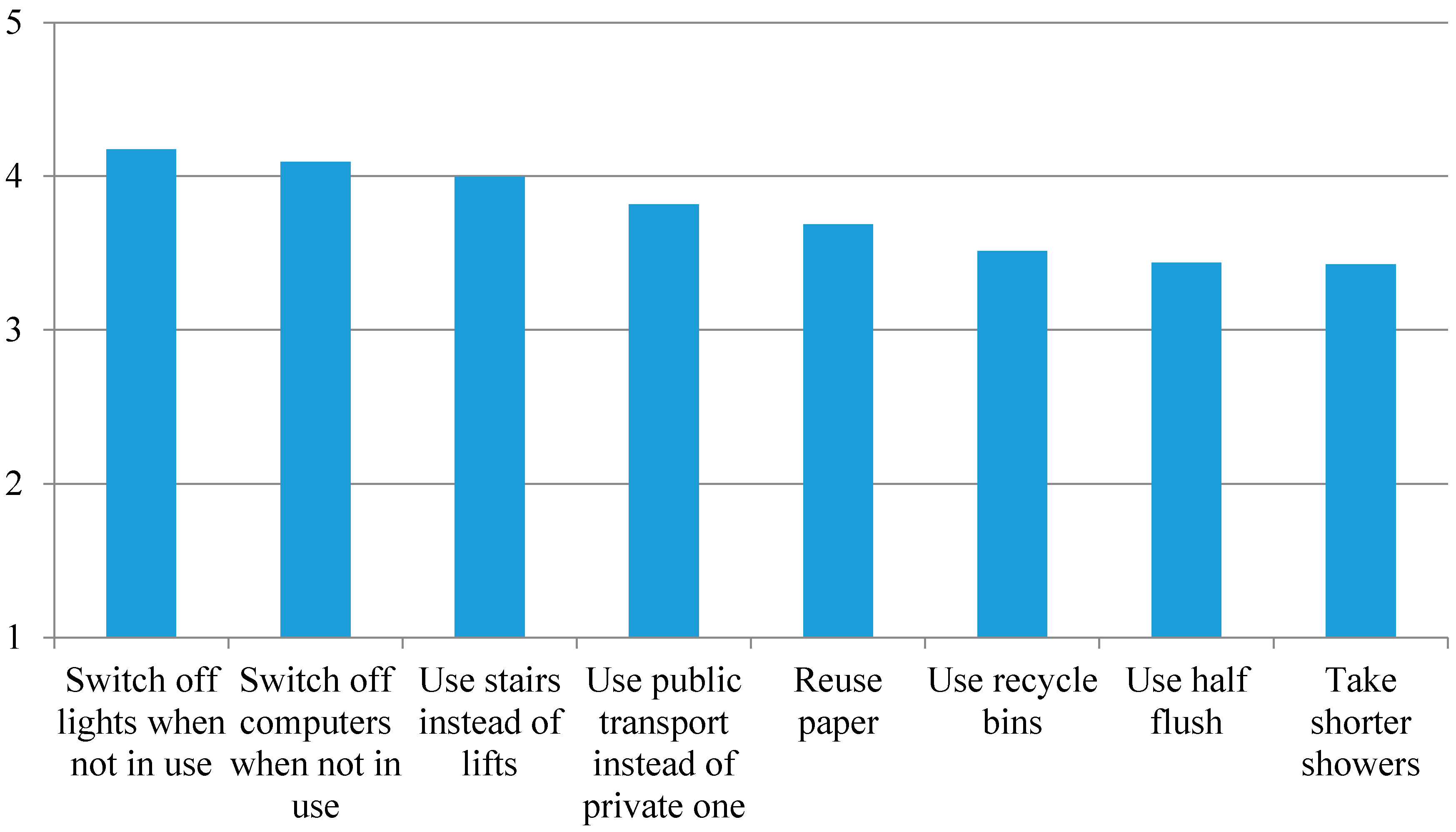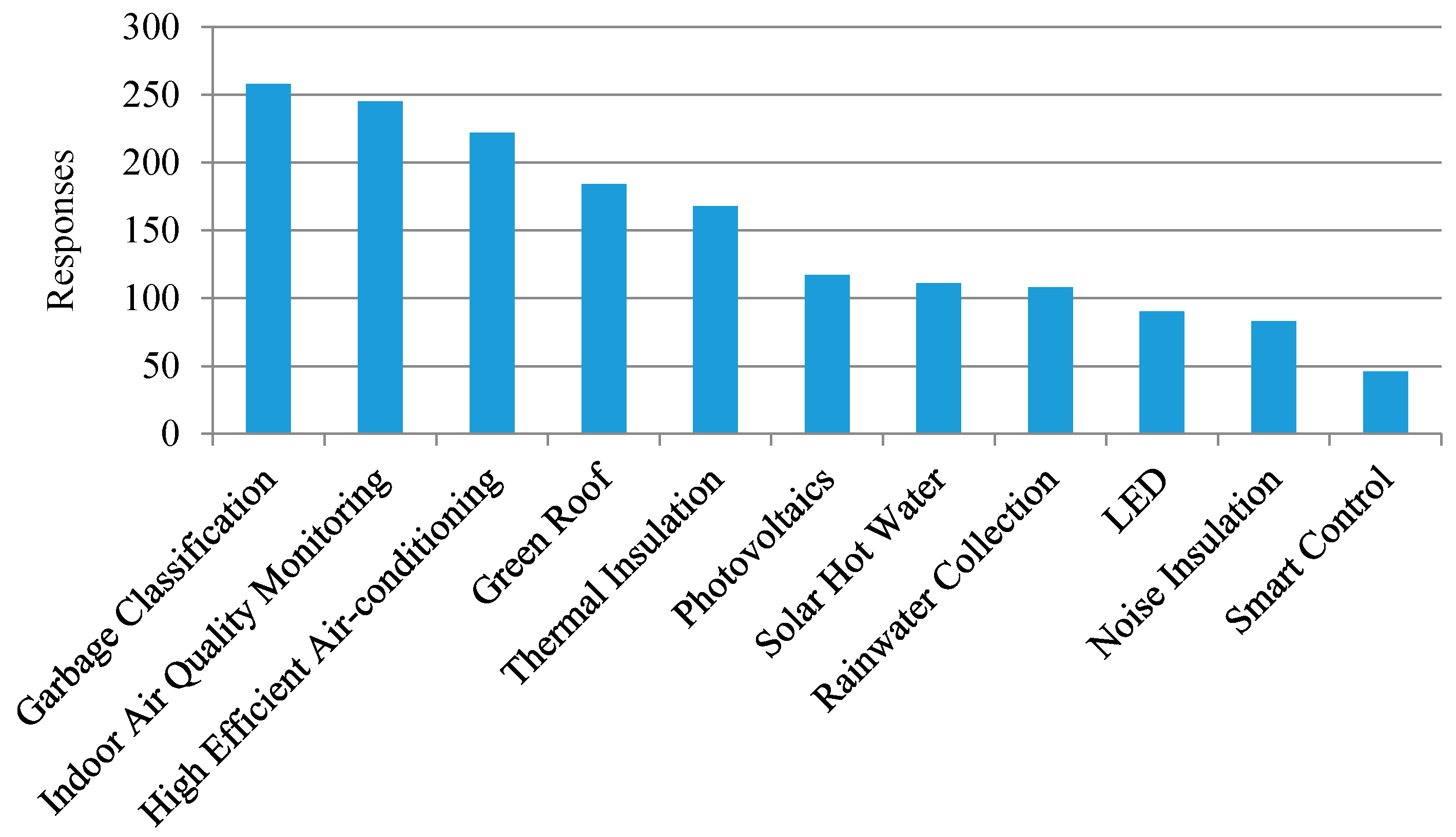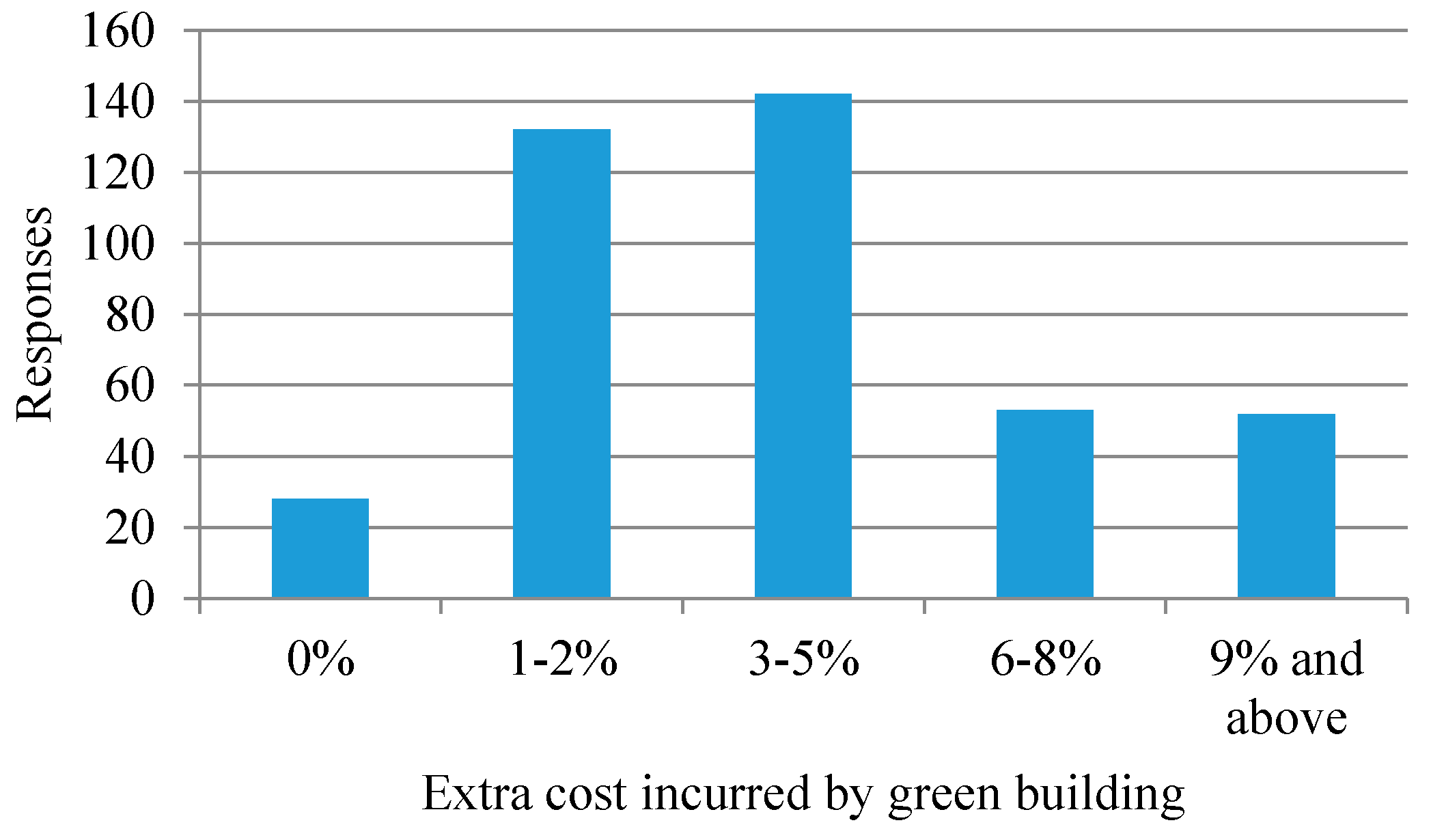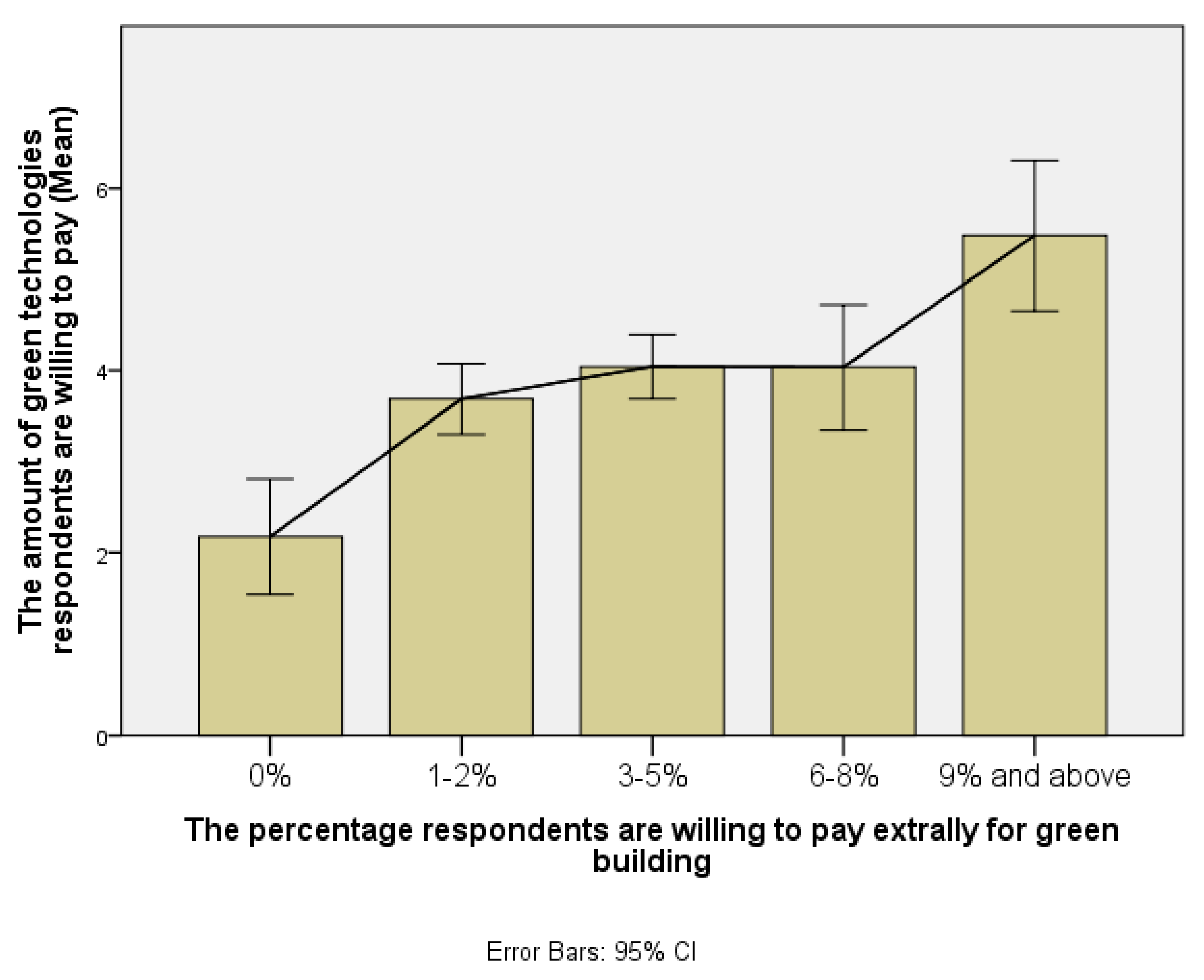Green Building Pro-Environment Behaviors: Are Green Users Also Green Buyers?
Abstract
:1. Introduction
1.1. Green Buildings
1.2. Pro-Environment Behavior
1.3. Objective
2. Materials and Methods
3. Results
3.1. Pro-Environmental Behaviors
3.2. Environmental Beliefs
4. Discussion
5. Conclusions
Acknowledgments
Author Contributions
Conflicts of Interest
References
- Intergovernmental Panel on Climate Change (IPCC). IPCC 5th Assessment Report; IPCC: Geneva, Switzerland, 2014. [Google Scholar]
- Yudelson, J. The Green Building Revolution; Island Press: Washington, DC, USA, 2008. [Google Scholar]
- Gou, Z.; Xie, X. Evolving green building: Triple bottom line or regenerative design? J. Clean. Prod. 2017, 153, 600–607. [Google Scholar] [CrossRef]
- U.S. Green Building Council (USGBC). Green Building and LEED Core Concepts; USGBC: Washington, DC, USA, 2009. [Google Scholar]
- Gou, Z.; Lau, S.S.-Y. Contextualizing green building rating systems: Case study of Hong Kong. Habitat Int. 2014, 44, 282–289. [Google Scholar] [CrossRef]
- Zuo, J.; Zhao, Z.-Y. Green building research–current status and future agenda: A review. Renew. Sustain. Energy Rev. 2014, 30, 271–281. [Google Scholar] [CrossRef]
- Newsham, G.R.; Mancini, S.; Birt, B.J. Do LEED-certified buildings save energy? Yes, but…. Energy Build. 2009, 41, 897–905. [Google Scholar] [CrossRef]
- Gill, Z.M.; Tierney, M.J.; Pegg, I.M.; Allan, N. Low-energy dwellings: The contribution of behaviors to actual performance. Build. Res. Inform. 2010, 38, 491–508. [Google Scholar] [CrossRef]
- Scofield, J.H. Efficacy of LEED-certification in reducing energy consumption and greenhouse gas emission for large New York City office buildings. Energy Build. 2013, 67, 517–524. [Google Scholar] [CrossRef]
- Pan, W.; Qin, H.; Zhao, Y. Challenges for energy and carbon modeling of high-rise buildings: The case of public housing in Hong Kong. Resour. Conserv. Recycl. 2017, 123, 208–218. [Google Scholar] [CrossRef]
- Janda, K.B. Buildings don’t use energy: People do. Architect. Sci. Rev. 2011, 54, 15–22. [Google Scholar] [CrossRef]
- Kamilaris, A.; Neovino, J.; Kondepudi, S.; Kalluri, B. A case study on the individual energy use of personal computers in an office setting and assessment of various feedback types toward energy savings. Energy Build. 2015, 104, 73–86. [Google Scholar] [CrossRef]
- Van Schaack, C.; BenDor, T. A comparative study of green building in urban and transitioning rural North Carolina. J. Environ. Plan. Manag. 2011, 54, 1125–1147. [Google Scholar] [CrossRef]
- Tsai, W.-H.; Yang, C.-H.; Huang, C.-T.; Wu, Y.-Y. The impact of the carbon tax policy on green building strategy. J. Environ. Plan. Manag. 2017, 60, 1412–1438. [Google Scholar] [CrossRef]
- Kats, G.; Alevantis, L.; Berman, A.; Mills, E.; Perlman, J. The Costs and Financialbenefits of Green Buildings. A Report to California’s Sustainable Building Taskforce; Capital E: Wellington, New Zealand, 2003. [Google Scholar]
- Kats, G. Greening Our Built World: Costs, Benefits, and Strategies; Island Press: Washington, DC, USA, 2010. [Google Scholar]
- Langdon, D. The Cost & Benefit of Achieving Green Buildings; Davis Langdon Management Consulting: London, UK, 2007. [Google Scholar]
- Jin-Lee, K.; Martin, G.; Sunkuk, K. Cost Comparative Analysis of a New Green Building Code for Residential Project Development. J. Constr. Eng. Manag. 2014, 140. [Google Scholar] [CrossRef]
- Steven Winter Associates. LEED Cost Study: A Report Submitted to the U.S. General Service Administration (GSA); U.S. General Service Administration (GSA): Washington, DC, USA, 2004.
- Dwaikat, L.N.; Ali, K.N. Green buildings cost premium: A review of empirical evidence. Energy Build. 2016, 110, 396–403. [Google Scholar] [CrossRef]
- Uğur, L.O.; Leblebici, N. An examination of the LEED green building certification system in terms of construction costs. Renew. Sustain. Energy Rev. 2017, in press. [Google Scholar]
- Darko, A.; Zhang, C.; Chan, A.P.C. Drivers for green building: A review of empirical studies. Habitat Int. 2017, 60, 34–49. [Google Scholar] [CrossRef]
- United Nations Environment Programme (UNEP). UNEP Frontiers 2016 Report: Emerging Issues of Environmental Concern; UNEP: Nairobi, Kenya, 2016. [Google Scholar]
- American Academy of Arts and Sciences (AAAS). Beyond Technology: Strengthening Energy Policy through Social Science; AAAS: Cambridge, MA, USA, 2011. [Google Scholar]
- Steg, L.; Vlek, C. Encouraging pro-environmental behavior: An integrative review and research agenda. J. Environ. Psychol. 2009, 29, 309–317. [Google Scholar] [CrossRef]
- Lindenberg, S.; Steg, L. Normative, Gain and Hedonic Goal Frames Guiding Environmental Behavior. J. Soc. Issues. 2007, 63, 117–137. [Google Scholar] [CrossRef]
- Stern, P.C.; Dietz, T.; Abel, T.; Guagnano, G.A.; Kalof, L. A Value-Belief-Norm Theory of Support for Social Movements: The Case of Environmentalism. Hum. Ecol. Rev. 1999, 6, 81–95. [Google Scholar]
- Ibtissem, M.H. Application of Value Beliefs Norms Theory to the Energy Conservation behavior. J. Sustain. Dev. 2010, 3, 129–139. [Google Scholar] [CrossRef]
- Lind, H.B.; Nordfjærn, T.; Jørgensen, S.H.; Rundmo, T. The value-belief-norm theory, personal norms and sustainable travel mode choice in urban areas. J. Environ. Psychol. 2015, 44, 119–125. [Google Scholar] [CrossRef]
- Staddon, S.C.; Cycil, C.; Goulden, M.; Leygue, C.; Spence, A. Intervening to change behavior and save energy in the workplace: A systematic review of available evidence. Energy Res. Soc. Sci. 2016, 17, 30–51. [Google Scholar] [CrossRef]
- Larson, L.R.; Stedman, R.C.; Cooper, C.B.; Decker, D.J. Understanding the multi-dimensional structure of pro-environmental behavior. J. Environ. Psychol. 2015, 43, 112–124. [Google Scholar] [CrossRef]
- Kaiser, F.G.; Kibbe, A. Pro-Environmental Behavior. In Reference Module in Neuroscience and Biobehavioral Psychology; Elsevier: Amsterdam, The Netherlands, 2017. [Google Scholar]
- Thøgersen, J. Spillover processes in the development of a sustainable consumption pattern. J. Econ. Psychol. 1999, 20, 53–81. [Google Scholar] [CrossRef]
- Truelove, H.B.; Carrico, A.R.; Weber, E.U.; Raimi, K.T.; Vandenbergh, M.P. Positive and negative spillover of pro-environmental behavior: An integrative review and theoretical framework. Glob. Environ. Change 2014, 29, 127–138. [Google Scholar] [CrossRef]
- Margetts, E.A.; Kashima, Y. Spillover between pro-environmental behaviors: The role of resources and perceived similarity. J. Environ. Psychol. 2017, 49, 30–42. [Google Scholar] [CrossRef]
- Fujii, S.; Kitamura, R. What does a one-month free bus ticket do to habitual drivers? An experimental analysis of habit and attitude change. Transportation 2003, 30, 81–95. [Google Scholar] [CrossRef]
- Gneezy, A.; Imas, A.; Brown, A.; Nelson, L.D.; Norton, M.I. Paying to Be Nice: Consistency and Costly Prosocial Behavior. Manag. Sci. 2011, 58, 179–187. [Google Scholar] [CrossRef]
- Chau, C.K.; Tse, M.S.; Chung, K.Y. A choice experiment to estimate the effect of green experience on preferences and willingness-to-pay for green building attributes. Build. Environ. 2010, 45, 2553–2561. [Google Scholar] [CrossRef]
- Jagers, S.C.; Harring, N.; Matti, S. Environmental management from left to right—On ideology, policy-specific beliefs and pro-environmental policy support. J. Environ. Plan. Manag. 2017, 1–19. [Google Scholar] [CrossRef]
- van Riper, C.J.; Kyle, G.T.; Sutton, S.G.; Yoon, J.I.; Tobin, R.C. Australian residents’ attitudes toward pro-environmental behavior and climate change impacts on the Great Barrier Reef. J. Environ. Plan. Manag. 2013, 56, 494–511. [Google Scholar] [CrossRef]
- Kaiser, F.G.; Byrka, K.; Hartig, T. Reviving Campbell’s Paradigm for Attitude Research. Personal. Soc. Psychol. Rev. 2010, 14, 351–367. [Google Scholar] [CrossRef] [PubMed]
- Gray, D.B. Ecological Beliefs and Behaviors: Assessment and Change; Greenwood Press: Westport, CT, USA, 1985. [Google Scholar]
- Corral-Verdugo, V.C.; Bechtel, R.B.; Fraijo-Sing, B. Environmental beliefs and water conservation: An empirical study. J. Environ. Psychol. 2003, 23, 247–257. [Google Scholar] [CrossRef]
- Kings, D.; Ilbery, B. The environmental belief systems of organic and conventional farmers: Evidence from central-southern England. J. Rural Stud. 2010, 26, 437–448. [Google Scholar] [CrossRef]
- Sarkis, A.M., Jr. A comparative study of theoretical behavior change models predicting empirical evidence for residential energy conservation behaviors. J. Clean. Prod. 2017, 141, 526–537. [Google Scholar] [CrossRef]
- Ministry of Housing and Urban-Rural Development (MOHURD). Study on the Economics of Green Buildings in China; Center of Science and Technology of Construction, MOHURD: Beijing, China, 2012. [Google Scholar]
- Dunlap, R.E.; Van Liere, K.D. The “New Environmental Paradigm”. J. Environ. Educ. 1978, 9, 10–19. [Google Scholar] [CrossRef]
- Noblet, C.L.; Anderson, M.; Teisl, M.F. An empirical test of anchoring the NEP scale in environmental ethics. Environ. Educ. Res. 2013, 19, 540–551. [Google Scholar] [CrossRef]
- Erdo, N. Testing the new ecological paradigm scale: Turkish case. Afr. J. Agric. Res. 2009, 4, 1023–1031. [Google Scholar]
- Leygue, C.; Ferguson, E.; Spence, A. Saving energy in the workplace: Why, and for whom? J. Environ. Psychol. 2017, 53, 50–62. [Google Scholar] [CrossRef]
- Agha-Hossein, M.M.; Tetlow, R.M.; Hadi, M.; El-Jouzi, S.; Elmualim, A.A.; Ellis, J.; Williams, M. Providing persuasive feedback through interactive posters to motivate energy-saving behaviors. Intell. Build. Int. 2015, 7, 16–35. [Google Scholar] [CrossRef]
- Lee, Y.-J.; De Young, R.; Marans, R.W. Factors Influencing Individual Recycling Behavior in Office Settings. Environ. Behav. 1995, 27, 380–403. [Google Scholar] [CrossRef]
- U.S. Green Building Council (USGBC). LEED Core Concept; USGBC: Washington, DC, USA, 2014. [Google Scholar]
- Ma, S.; Ma, J. Current situation and countermeasure of municipal domestic waste sorting collection in China. Environ. Sanit. Eng. 2007, 15, 12–14. [Google Scholar]
- Balta-Ozkan, N.; Davidson, R.; Bicket, M.; Whitmarsh, L. Social barriers to the adoption of smart homes. Energy Policy 2013, 63, 363–374. [Google Scholar] [CrossRef]
- Dunlap, R.E.; Van Liere, K.D.; Mertig, A.G.; Jones, R.E. New Trends in Measuring Environmental Attitudes: Measuring Endorsement of the New Ecological Paradigm: A Revised NEP Scale. J. Soc. Issues 2000, 56, 425–442. [Google Scholar] [CrossRef]
- D’Alessandro, D.; Tedesco, P.; Rebecchi, A.; Capolongo, S. Water use and water saving in Italian hospitals. A preliminary investigation. Ann. Ist. Super. Sanità 2016, 52, 56–62. [Google Scholar] [PubMed]
- Gilg, A.; Barr, S. Behavioral attitudes towards water saving? Evidence from a study of environmental actions. Ecol. Econ. 2006, 57, 400–414. [Google Scholar] [CrossRef]
- Köpetz, C.; Faber, T.; Fishbach, A.; Kruglanski, A.W. The multifinality constraints effect: How goal multiplicity narrows the means set to a focal end. J. Personal. Soc. Psychol. 2011, 100, 810–826. [Google Scholar] [CrossRef] [PubMed]
- Thøgersen, J.; Ölander, F. Spillover of environment-friendly consumer behavior. J. Environ. Psychol. 2003, 23, 225–236. [Google Scholar] [CrossRef]
- Olubunmi, O.A.; Xia, P.B.; Skitmore, M. Green building incentives: A review. Renew. Sustain. Energy Rev. 2016, 59, 1611–1621. [Google Scholar] [CrossRef]
- Gou, Z.; Lau, S.S.-Y.; Prasad, D. Market readiness and policy implications for green buildings: Case study from Hong Kong. J. Green Build. 2013, 8, 162–173. [Google Scholar] [CrossRef]
- Ma, C.; Rogers, A.A.; Kragt, M.E.; Zhang, F.; Polyakov, M.; Gibson, F.; Chalak, M.; Pandit, R.; Tapsuwan, S. Consumers’ willingness to pay for renewable energy: A meta-regression analysis. Resour. Energy Econ. 2015, 42, 93–109. [Google Scholar] [CrossRef]




| No. | Location | Rating System | Year Built or Certified | Number of Participants | Main Green Features |
|---|---|---|---|---|---|
| 1 | Shenzhen | GBL | 2009 | 82 | Green roofs, atrium, water cooling system, photovoltaic panels, indoor plants, operable windows |
| 2 | Shenzhen | GBL | 2009 | 75 | Atrium, independent temperature-humidity control air conditioning system, intelligent blinds |
| 3 | Shanghai | LEED | 2010 | 55 | Wetland ecological system, photovoltaic panels, heat pumps, silicon cooling system, indoor greenery, electrical fans, operable windows |
| 4 | Shanghai | GBL | 2007 | 42 | Green roofs, grey water recycling, solar hot water, ground cooling system, indoor greenery, electrical fans, operable windows |
| 5 | Guangzhou | GBL | 2009 | 60 | A courtyard, pervious pavement, grey water recycling, photovoltaic panels, heat pumps, operable windows |
| 6 | Shenzhen | LEED | 2008 | 50 | Green roofs, grey water recycling, rain water harvesting, photovoltaic panels, task lights, movable louvers |
| 7 | Shanghai | LEED | 2010 | 48 | Water-saving appliances, Energy Star labelled office appliances, certified low VOC (Volatile organic compounds) materials, indoor greenery |
| Pro-environment Behaviors | V1 | V2 | V3 | |
|---|---|---|---|---|
| Willingness to pay for green technologies V1 | Pearson Correlation | 1 | 0.247 ** | 0.241 ** |
| Sig. (2-tailed) | 0.000 | 0.006 | ||
| Willingness to pay for extra cost of green building V2 | Pearson Correlation | 0.247 ** | 1 | 0.0.232 ** |
| Sig. (2-tailed) | 0.000 | 0.004 | ||
| Energy saving behaviors V3 | Pearson Correlation | 0.241 ** | 0.232 ** | 1 |
| Sig. (2-tailed) | 0.006 | 0.004 | ||
| NEP Statements | Loading | |
|---|---|---|
| Limits to Growth/Eco-Crisis | Anthropocentrism/Exemptionalism | |
| 1: We are approaching the limit of the number of people the earth can support. | 0.635 | −0.159 |
| 2: Humans have the right to modify the natural environment to suit their needs. | −0.078 | 0.691 |
| 3: When humans interfere with nature it often produces disastrous consequences. | 0.797 | 0.041 |
| 4: Human ingenuity will insure that we do not make the earth unlivable. | 0.066 | 0.752 |
| 5: Humans are seriously abusing the environment. | 0.727 | 0.023 |
| 6: The earth has plenty of natural resources if we just learn how to develop them. | −0.182 | 0.623 |
| 7: Plants and animals have as much right as humans to exist. | 0.609 | 0.016 |
| 8: The balance of nature is strong enough to cope with the impacts of modern industrial nations. | 0.215 | 0.695 |
| 9: Despite our special abilities, humans are still subject to the laws of nature. | 0.771 | 0.164 |
| 10: The so-called “ecological crisis” facing humankind has been greatly exaggerated. | 0.258 | 0.648 |
| 11: The earth is like a spaceship with very limited room and resources. | 0.744 | 0.161 |
| 12: Humans were meant to rule over the rest of nature. | 0.178 | 0.732 |
| 13: The balance of nature is very delicate and easily upset. | 0.697 | 0.001 |
| 14: Humans will eventually learn enough about how nature works to be able to control it. | −0.019 | 0.755 |
| 15: If things continue on their present course, we will soon experience a major ecological catastrophe. | 0.764 | 0.115 |
| Title | Limits to Growth and Eco-Crisis (Standard Coefficient) | Anthropocentrism and Exemptionalism (Standard Coefficient) | R2 | Sig. |
|---|---|---|---|---|
| Willingness to pay for green technologies | 0.585 *** | 0.140 | 0.352 | 0.000 |
| Willingness to pay for green buildings | 0.233 *** | 0.081 | 0.223 | 0.000 |
| Switch off electricity after leaving homes | 0.268 *** | 0.039 | 0.367 | 0.000 |
| Take quick shower | 0.225 *** | 0.007 | 0.220 | 0.001 |
| Use half flush | 0.177 *** | 80.039 | 0.209 | 0.001 |
| Choose most energy efficient appliances | 0.227 *** | −0.015 | 0.306 | 0.000 |
| Use your own shopping bags | 0.238 *** | −0.068 | 0.340 | 0.000 |
| Use public transport | 0.201 *** | 0.005 | 0.302 | 0.000 |
| Recycle used items | 0.165 ** | −0.021 | 0.220 | 0.001 |
| Sort garbage before disposing | 0.164 ** | −0.107* | 0.237 | 0.000 |
© 2017 by the authors. Licensee MDPI, Basel, Switzerland. This article is an open access article distributed under the terms and conditions of the Creative Commons Attribution (CC BY) license (http://creativecommons.org/licenses/by/4.0/).
Share and Cite
Xie, X.; Lu, Y.; Gou, Z. Green Building Pro-Environment Behaviors: Are Green Users Also Green Buyers? Sustainability 2017, 9, 1703. https://doi.org/10.3390/su9101703
Xie X, Lu Y, Gou Z. Green Building Pro-Environment Behaviors: Are Green Users Also Green Buyers? Sustainability. 2017; 9(10):1703. https://doi.org/10.3390/su9101703
Chicago/Turabian StyleXie, Xiaohuan, Yi Lu, and Zhonghua Gou. 2017. "Green Building Pro-Environment Behaviors: Are Green Users Also Green Buyers?" Sustainability 9, no. 10: 1703. https://doi.org/10.3390/su9101703
APA StyleXie, X., Lu, Y., & Gou, Z. (2017). Green Building Pro-Environment Behaviors: Are Green Users Also Green Buyers? Sustainability, 9(10), 1703. https://doi.org/10.3390/su9101703







